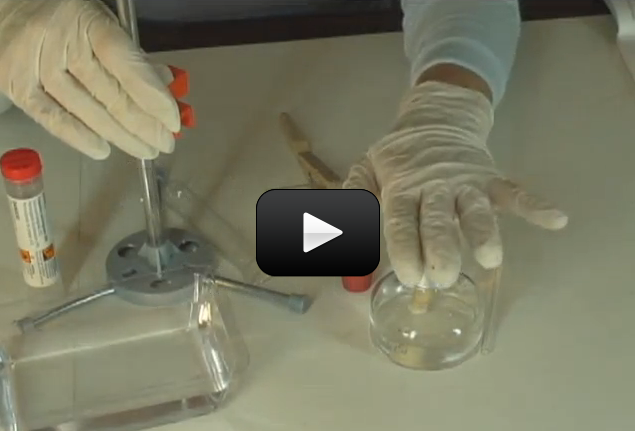This experiment is for advanced students.
This time we’re going to use a lot of equipment… really break out all the chemistry stuff. We’ll need all this stuff to generate oxygen with potassium permanganate (KMNO4). We will work with this toxic chemical and we will be careful…won’t we?
[am4show have=’p8;p9;p11;p38;p92;p52;’ guest_error=’Guest error message’ user_error=’User error message’ ]
Oxygen is pretty important… it’s only the single most important thing that mammals need. Besides breathing, oxygen is important for so much on this world. Oxygen is used in welding, rocket fuel, and water treatment. Without oxygen, there is no oxidation and no fire. Simply put, we wouldn’t have rusty bicycles or campfires. Can your believe it?
Potassium permanganate is an important chemical in the film industry. It is used to make props like cloth, ropes, and glass, appear “old”. Some films it has been used in are “Troy”, “Indiana Jones”, and “300”. The KMnO4 stains any organic material. KMnO4 is also used as an antiseptic, and is used to treat skin ulcers and rashes. It is also used to treat foot fungus…..phew! People living in the country are sometimes plagued with an iron taste or a rotten egg smell in the water from their wells. Potassium permanganate can be used to remove the taste and smell from the water.
Materials:
- Chemistry stand
- Plastic tub
- Water
- 2 test tubes
- Test tube clamp
- Potassium permanganate (KMnO4) (MSDS)
- Alcohol burner
- Lighter
- One-hole rubber stopper
- Solid rubber stopper
- 900 bend glass tube
- Measuring spoon
- Rubber tubing
- Match
- Wooden splint
Be careful inserting the glass tubing into the stopper. Wet the short end of the glass tube with water and gently push and twist the glass through the stopper. Wear work gloves and work carefully and slowly. Do not use oil or grease you have laying around the house.
When lighting the oxygen in the test tube, use a wooden splint. Wooden splints can be purchased from craft stores, or make your own by shaving thin strips from a piece of pine wood.
C3000: Experiment
Download Student Worksheet & Exercises
Here’s what’s going on in this experiment:
2KMnO4 + heat –> K2MnO4 + MnO2 + O2
Potassium permanganate is heated and produces potassium manganate, manganese dioxide, and oxygen
Oxygen is generated by heating the KMnO4, and is collected in the test tubes. We will test the contents of the tubes to see if oxygen has been generated. What do you think will happen when a glowing splint is pushed up inside the test tube? Don’t know? Do the experiment and try to figure it out. Remember, in order for there to be flame, you need fuel and oxygen. If that gas was carbon dioxide, what would happen when the glowing splint was placed inside?
Cleanup: Clean everything thoroughly after you are finished with the lab. After cleaning with soap and water, rinse thoroughly. Chemists use the rule of “three” in cleaning glassware and tools. After washing, chemists rinse out all visible soap and then rinse three times more.
Storage: Place all chemicals, cleaned tools, and glassware in their respective storage places.
Disposal: Dispose of all solid waste in the garbage. Liquids can be washed down the drain with running water. Let the water run awhile to ensure that they have been diluted and sent downstream.
[/am4show]


Oops! There’s a mistake in that equation. That first O2 should be HEAT not O2. And then it balances… sorry! I’ll fix that…
Hi,
Me and my dad did this experiment and we were a little confused by the equation, 2KMnO4 + O2 –> K2MnO4 + MnO2 + O2, the oxygen seems imbalanced. Is oxygen an input in this experiment?
Thank You.
The oxygen (O2) generated in the test tube is the same as the O2 in the air around us. The difference is the amount. The air we breathe is made up of many different gasses including nitrogen, oxygen, and argon. Of all those gases, O2 makes up on only 20.9% of our atmosphere (at sea level). The gas generated by this chemical reaction is pure O2. Therefore, the gas that is displacing the water in the test tube is almost 100% O2.
What’s the difference between the oxygen you harvested, to the oxygen around us? Is that pure oxygen in the bottle?